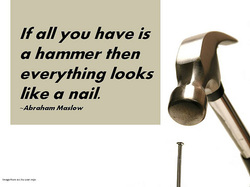ETEC 565 - Learning Technologies: Selection, Design and Application
Evaluating, selecting and applying various learning technologiesWhen renovating a home or building, the CMHC website is a valuable resource. Focus questions like "Is your renovation adaptable?" or "Is your renovation practical?" can also be applied to the selection, design and application of learning technologies. Being clear about the goals and expectations, building equity (both financial and learning), and taking a long view when planning for future needs is good advice in renovations and learning technologies. Taking time to plan, organize, prepare and practice skills before and during a project is as important in teaching and learning as it is in renovating.
|
Immediate ValueA meaningful activity described and my experience of it.
|
A meaningful activity in ETEC 565 was the creation of a reflective, goal oriented portfolio blog found at http://blogs.ubc.ca/hjdew/ My personal learning, supported through a structured exploration of a wide variety of technologies, came from the process of creating the blog and each individual assignment captured within the blog. For this course, the immediate value was in the doing and creating, although both process and product had immediate value.
My renovations in ETEC 565 began when I climbed into the technology ‘sandbox’ created by the course designers. As with all renovation spaces, this course provided time to play with ideas, create new environments, explore new ways of doing things, and investigate potential outcomes. Dreaming of new living spaces mirrored my dreams of creating a new learning space. Yet, dreaming isn’t enough. Getting down to the hard work of creating and realizing the dream is part of a renovation job. |
Potential ValueSpecific resource from this activity and why it is useful
|
The resource created is a blog site that captures the trials, challenges and successes of applying technology tools to learning environments. Through capturing the ongoing the explorations, I created a record and reflections of the step-by-step processes of learning with technology.
The blog exemplifies a model of self-directed, technology explorations and tinkering with purposeful, goal directed learning. This is a valuable resource for my own on-going reflection. It also provides value as a model for colleagues and students. As renovators in the real world are quick to state - tinkering is part of the job. Trial and error is a valued learning strategy. You need to practice first. |
Applied ValueHow I used this resource in my practice and what it has enabled.
|
Through the ‘tinkering’ and exploring of technologies in a structured and supportive learning environment, I was able to develop technological expertise. By analyzing and synthesizing the learning in a public space, I was accountable for my learning as a model for others. I became more proficient in the design of public learning spaces as a result of ETEC 565A.
When renovating a house, you use lots of tools to create the changes. You craft the finished living space through a slow, laborious process of completing one thing at a time. You tinker and gain expertise through practice. Such was the experience of ETEC 565A. I had the opportunity to use a wide variety of technology tools. Some were difficult, others I used reluctantly, but all the while, I learned to take on new challenges and become more comfortable taking risks. |
Realized ValuePersonal and organizational affect and success resulting from the activity and artifacts.
|
My personal success was an
· appreciation of the challenges in learning something new if not supported or goal oriented · understanding of the importance of capturing and measuring process as well as product · increased ability to take risks when creating with unknown and challenging tools and tasks Organizational success has come in the form of renewing and reshaping authentic, constructivist learning tasks for students within the faculty of education. Blogging is one tool providing a renovated learning space for the students. With the individual tasks in ETEC 565A, I was renovated into someone who knew a little about a multitude of technology tools. I was renewed in my ability to apply structures and frameworks to technology supported learning environments. My ability to shim, shape, and shift tools to suit purpose and audience was regenerated. |
Reframed ValueNew definition of success
|
Success is measured in small steps. By reframing the value of process rather than product, success is measured in the journey toward the goal, not the goal itself. In completing the final synthesis in ETEC 565A (http://blogs.ubc.ca/hjdew/synthesis/) I reflected on this quote from T.S. Elliot: “We shall not cease from exploration, and the end of all our exploring will be to arrive where we started, and know the place for the first time.” Success is found in the exploring.
Renovations are a process of change. There is a final product as the goal, but it is the process of deconstruction and reconstruction that is the heart of renovation. When the project is finished, so is the renovation. ETEC 565A reframed my understanding of success in teaching and learning with educational technology. |
References and Research that supported 'my renovations'
Chickering, A.W. & Gamson, Z.F. (1987). Seven Principles for Good Practice in Undergraduate Education. American Association for Higher Education Bulletin, 39 (7), 3-7.
Chickering, A.W. & Ehrmann, S.C. (1996). Implementing the Seven Principles: Technology as Lever. American Association for Higher Education Bulletin, 49(2), 3-6.
Fullan, M., Hill, P. & Crévola, C. (2006). Breakthrough. Corwin Press.
Siemens, G. (2003). Evaluating Media Characteristics: Using multimedia to achieve learning outcomes. Elearnspace. Retrieved from http://www.elearnspace.org/Articles/mediacharacteristics.htm
Siemens, G. (2006). Knowing Knowledge. Creative Commons Licensed. Retrieved from http://www.elearnspace.org/KnowingKnowledge_LowRes.pdf
Chickering, A.W. & Ehrmann, S.C. (1996). Implementing the Seven Principles: Technology as Lever. American Association for Higher Education Bulletin, 49(2), 3-6.
Fullan, M., Hill, P. & Crévola, C. (2006). Breakthrough. Corwin Press.
Siemens, G. (2003). Evaluating Media Characteristics: Using multimedia to achieve learning outcomes. Elearnspace. Retrieved from http://www.elearnspace.org/Articles/mediacharacteristics.htm
Siemens, G. (2006). Knowing Knowledge. Creative Commons Licensed. Retrieved from http://www.elearnspace.org/KnowingKnowledge_LowRes.pdf





